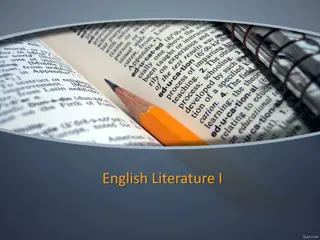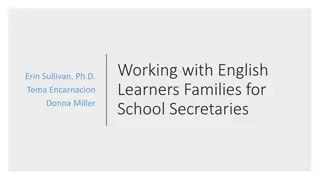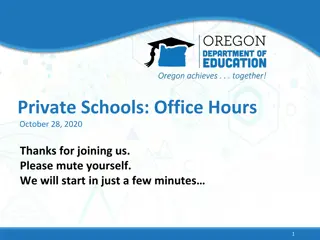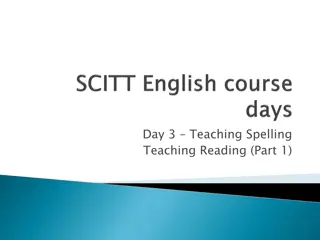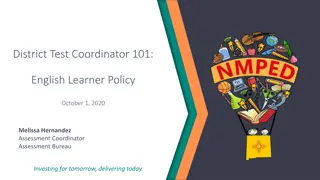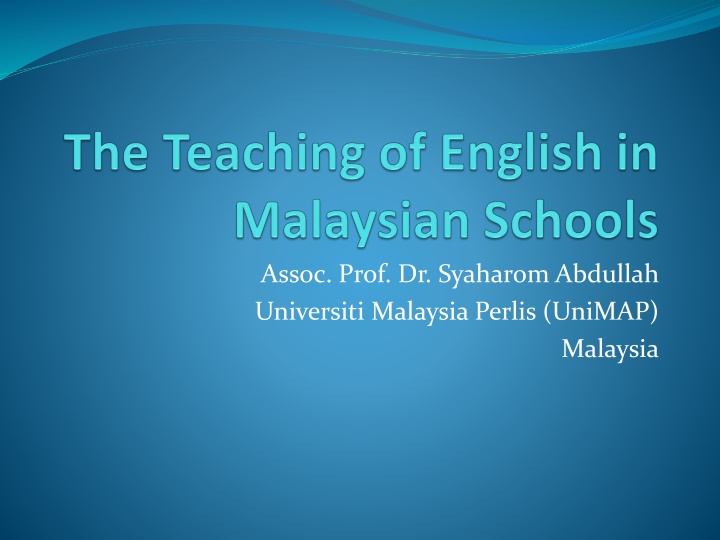
Evolution of English Language Education in Malaysian Schools
Explore the historical development of English language education in Malaysia, from pre-British colonization to present-day practices. Discover how the curriculum in primary schools focuses on equipping learners with essential language skills for effective communication both orally and in writing.
Download Presentation

Please find below an Image/Link to download the presentation.
The content on the website is provided AS IS for your information and personal use only. It may not be sold, licensed, or shared on other websites without obtaining consent from the author. If you encounter any issues during the download, it is possible that the publisher has removed the file from their server.
You are allowed to download the files provided on this website for personal or commercial use, subject to the condition that they are used lawfully. All files are the property of their respective owners.
The content on the website is provided AS IS for your information and personal use only. It may not be sold, licensed, or shared on other websites without obtaining consent from the author.
E N D
Presentation Transcript
Assoc. Prof. Dr. Syaharom Abdullah Universiti Malaysia Perlis (UniMAP) Malaysia
Historical Development Pre-British colonisation Informal and religious studies British colonisation four types of primary school Malay-medium, English-medium, Chinese-medium and Tamil-medium schools. Each used different mediums of instruction and provided a different syllabus. English medium secondary schools English medium tertiary education
Historical Development After independence (1957) (1958) Malay medium secondary schools were introduced. (1967) Malay was declared the sole national language. (1968) English medium primary schools were converted to Malay-medium schools. (1973) Malay was used to teach art stream in English medium secondary schools.
Historical Development (1975) Malay was the medium for all secondary schools (except independent Chinese secondary schools) English was taught as a subject. (1980) Malay was used to teach art courses at university. (1982) Malay was fully used in all secondary schools. (1983) Malay was used to teach all university programmes. (2003) English was used to teach Math and Science. (2012) Malay was used again to teach Math and science
The Teaching of English English is taught in all primary and secondary schools in the country in keeping with its status as a second language in the country since 1970.
Primary School The English curriculum for primary schools is designed to provide learners with a strong foundation in the English language. Learners will then be able to build upon this foundation and use the language for various purposes.
English in Primary School AIMS The English language syllabus for primary schools aims to equip learners with basic skills and knowledge of the English language so as to enable them to communicate, both orally and in writing, in and out of school. 240 minutes of English for primary 1 3 and 210 minutes for primary 4 6 per week in national schools. 60 minutes of for primary 3 and 90 minutes for primary 4 6 per week in national type Chinese and Tamil school.
English in Primary School OBJECTIVES By the end of the primary school, learners should be able to: listen to and understand simple spoken English in certain given contexts; II. ask and answer questions, speak and express themselves clearly to others using simple language; III. acquire good reading habits to understand, enjoy and extract information from a variety of texts; I.
English in Primary School IV. write legibly and express ideas in simple language; and V. show an awareness and appreciation of moral values as well as love for the nation.
English in Primary School Language Skills The language skills of listening, reading and writing form the core of the primary English curriculum. Learners use these skills to talk to and write to people, to obtain information from various sources, and to enjoy a poem or story read or heard.
English in Primary School The skill of Listening is taught to enable learners to listen carefully to what is spoken so that they are able to obtain as much and as accurately as possible the information or ideas heard. Oral skills are taught to enable learners to express their ideas confidently and clearly. For this purpose, learners are taught to pronounce words correctly and to speak with correct stress, intonation and sentence rhythm.
English in Primary school The skill of Reading is taught to enable learners not only to read independently a variety of texts but also to read with understanding so that they are able to extract information efficiently. The skill of Writing is taught to enable learners to express their ideas clearly on paper in legible handwriting or to communicate via the electronic media if facilities are available in school.
Teaching Approach Structural-situational approach
Secondary School AIMS The syllabus aims to extend learners English language proficiency in order to meet their needs to use English in certain situations in everyday life, for knowledge acquisition, and for future workplace needs.
English in Secondary School OBJECTIVES By the end of their secondary school education, learners should be able to: form and maintain relationships through conversations and correspondence; take part in social interaction; and interact to obtain goods and services ; II. obtain, process and use information from various audio-visual and print sources, and present the information in spoken and written form; I.
English in Secondary School III. listen to, view, read and respond to different texts, and express ideas, opinions, thoughts and feelings imaginatively and creatively in spoken and written form; and IV. show an awareness and appreciation of moral values and love towards the nation.
English in Secondary School Language Use The three areas of language use are the Interpersonal, the Informational, and the Aesthetic. Language for Interpersonal purposes enables learners to establish and maintain friendships and also collaborate with people to do certain things;
English in Secondary School Language for Informational purposes enables learners to use language to obtain, process, and give information. Language for Aesthetic purposes enables learners to enjoy literary texts at a level suited to theirlanguage and to express themselves creatively.
English in Secondary school Language Skills The language skills of listening, speaking, reading, and writing form the core of the curriculum. Learners use these skills to interact with people, obtain information and present information, respond to literary texts, and express themselves creatively.
English in Secondary School The skill of listening enables learners to understand and extract information relevant to their needs or to enjoy the sounds and rhythm of speech as in poetry and song. Oral skills will enable learners to convey their thoughts and ideas clearly in speech when they pronounce words correctly and observe correct stress and intonation.
English in Secondary School The skill of reading a variety of texts will enable learners to adjust the speed and style of their reading to suit the purpose at hand and to extract both implicit and explicit meanings from the text. Writing skills will enable learners to present their ideas in a logical and organised manner.
Teaching Approach The structural-situational syllabus for lower secondary (Form 1 3) The Malaysian Communicative Syllabus (task-oriented situational approach) for upper secondary (Form 4 5) (in 1986, the communication language teaching approach was recommended for use in secondary education.)
Mastery of English Malaysian University Entrance Test (MUET) All students who wish to pursue a tertiary degree must take the MUET
Test Components Test Component Code Time allocation (minutes) Maximum possible score Weightage (%) Listening 800/1 30 45 15 Speaking 800/2 30 45 15 Reading 800/3 120 135 45 Writing 800/4 90 75 25
Classification Aggregated Score Band User Command of Language Communication Ability COMPREHENSIO N Task Performance 260-300 6 Highly proficient user Very good command of the language Very fluent; highly appropriate use of language; hardly any grammatical error Very good understanding of language and context Very high ability to function in the language 220-259 5 Proficient user Good command of the language Fluent; appropriate use of language; few grammatical errors Good understanding of language and context High ability to function in the language 180-219 4 Satisfactory user Satisfactory command of the language Generally fluent; generally appropriate use of language; some grammatical errors Satisfactory understanding of language and context Satisfactory ability to function in the language
Classification 140-179 3 Modest user Fair command of the Fairly fluent; fairly appropriate use of language; many Fair understanding of language and Fair ability to function in the language 140-179 3 Fair command of the language language Fairly fluent; fairly appropriate use of language; many grammatical errors grammatical errors Not fluent; inappropriate use of language; very frequent grammatical errors Fair understanding of language and context context Fair ability to function in the language Modest user 100-139 100-139 2 2 Limited user Limited user Limited command Limited understanding Limited ability to Limited command of the language of the language Not fluent; inappropriate use of language; very frequent grammatical errors Limited understanding of language and context of language and context Limited ability to function in the language function in the language 0-99 1 Very limited user Very limited user Poor command of the language Poor command of the language Hardly able to use the language Hardly able to use the language Very limited understanding of language and context Very limited understanding of language and context Very limited ability to function in the language Very limited ability to function in the language 0-99 1
Performance in MUET Band 3 = % Year Band 1 % Band 2 % Band 3 % Band 4 % Band 5 % Band 6 % Candidates June 2010 21.10 45.02 26.52 6.62 0.74 0 85,464 33.86 Nov 2010 13.28 40.70 35.48 9.56 0.97 0.01 98,662 46.02 June 2011 21.81 31.38 28.91 11.54 1.35 0.01 85044 41.81 Nov 2011 15.15 38.05 35.77 10.24 0.79 0 93869 46.80 July 2012 60558 23.94 Nov 2012 75589 36.22
Issues Teaching focus and approach English as a universal set of discreet cognitive skills Focus on national examination Rote learning, pattern and question drillings Focus on literacy skills (reading and writing) and neglect of oracy skills (listening and speaking) Extensive use of L1 to teach especially in rural schools
Issues L1 interference Grammar, morphology and syntax EFL vs ESL environment Teachers English language competency National education policy
Challenges Making the learners actively involve in language learning process both inside and outside of the classroom Teachers need to connect and situate English literacy learning in the learners social lives. Then learning English will no longer be perceived as irrelevant and devoid of context.



